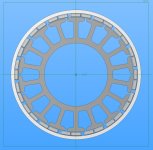John in CR
100 TW
Miles said:That's around 45Nm of torque. I'd guess not.John in CR said:Could handle a 10-12kw input in the 2000-2500rpm range?
Really? I must be missing something in the sizing relationship. I run my motor with the 150mm dia 50mm long stator at 6kw input limits with max rpm on the road of 1045rpm at voltage sagging to 75V. That's a sealed motor, plus I'm running it conservatively. It has plenty more to give, since it's never gotten remotely hot, so at higher voltage and maybe ventilation if necessary, I'm confident that 12-15kw input is a piece of cake at 2-2.5krpm.
I don't understand why a 112mm diameter 100mm long stator isn't more motor. It's roughly 50% more magnet area working at only 35% less radius and a better winding factor due to the longer stator. If necessary, a simple radial fan blade goes on the end for far better cooling than is possible with my more closed motor. Of course I'd like to see a larger diameter, but my plate is so full I have to be mostly a follower on this one.
John



